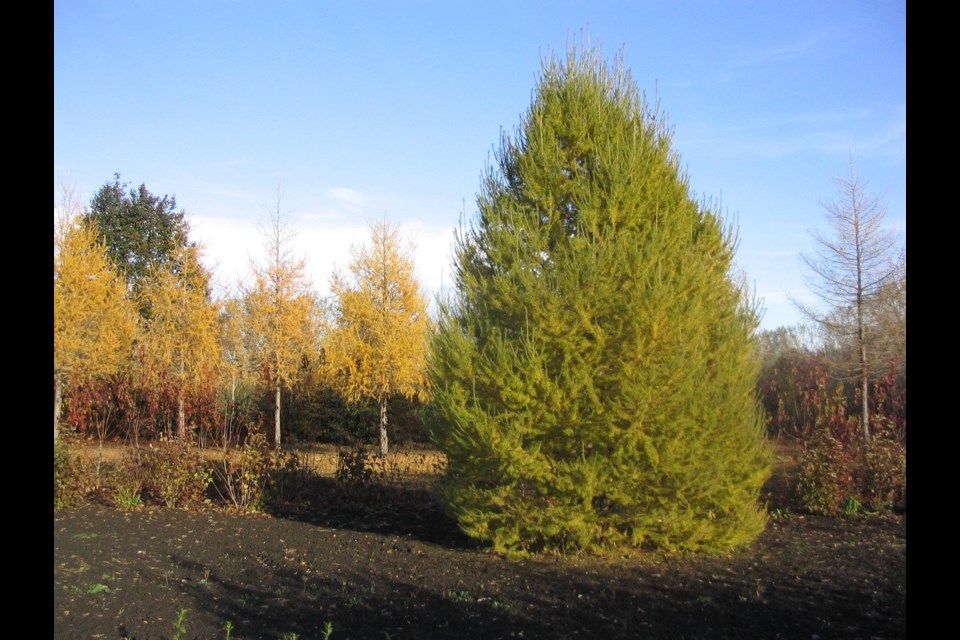Most prairie readers are familiar with pine and spruce, which are readily encountered in our urban and rural yards. Larch and fir are less commonly seen and sometimes less readily available but make wonderful additions to our landscapes. Try them. You won’t be disappointed.
Larch (Larix) is a deciduous conifer native to boreal and alpine regions. Its seeds are formed in cones, making it a conifer. But it is not “evergreen.” The needles, formed singly in first-year shoots and in clusters on short spurs in subsequent years, turn a lovely golden yellow in autumn and then drop. Larix is the classical name for this genus which larch is probably derived from. The term was first used in England following the Norman Conquest in 1066 and referred to a bowman or archer – who presumably used the wood in his bow and arrows.
Larch grow well in full sun and are best planted in early spring before their needles have expanded. Three larch species do well on the Canadian prairies.
The American larch or tamarack (Larix laricina), native to the swamps of the North America’s boreal forests, does best with even moisture, but adapts well to normal garden conditions. About 15 m high and 6 m wide (50 ft. x 20 ft.), it has a narrow pyramidal form with upswept branches. The bark is smooth and grey when young, developing reddish-brown scaly plates with age. The needles are a bright bluish green and the attractive small cones resemble tiny wooden rosettes. Tamarack comes from an Algonquin word, akemantak, meaning "wood used for snowshoes." Cut in thin strips, it was used by the Algonquian people for making snowshoes. Native Americans also used the rootlets of the tamarack to sew birch bark together when making canoes. And the poles were part of the early “corduroy roads” (a type of timber trackway for crossing over low or swampy areas) because of their resistance to rot.
The European larch (Larix decidua) is native to the mountains of central and northern Europe.
The species name, decidua, indicates that it is deciduous and will lose its needles each fall. It is a
large pyramidal tree, 20 m x 8 m (65 ft. x 26 ft.), with upswept branches that become horizontal with age. The needles are a soft, medium green, turning a wonderful golden yellow in fall. It does well in full sun on well-drained soil.
Larix decidua ‘Pendula’ is a smaller, weeping variety with an attractive but somewhat irregular form of about 3-4 m (10-13 ft.) in height at maturity. It is best used as an accent in the garden.
The Siberian larch (Larix sibirica) is native from northeastern Russia through to western Siberia, and, like most plants from Siberia, is well adapted to the prairies. In Russia, its resin was long used as chewing gum. It is a large pyramidal tree of 20 m x 15 m (65 ft. x 50 m) tall and wide, fast growing and drought-tolerant once established. The bark is yellowish on young twigs, aging first to reddish brown and later to dark greyish brown with deep furrows. The wood is tough and resistant to rot and has long been valued as fence posts, poles, sleepers on railroad tracks and props for mines. ‘Oasis’ is a recent denser and more rounded form introduced by Rick Durand.
Sara Williams is the author and coauthor of many books including Creating the Prairie Xeriscape, Gardening Naturally with Hugh Skinner and, with Bob Bors, the recently published Growing Fruit in Northern Gardens. She continues to give workshops on a wide range of gardening topics throughout the prairies.
This column is provided courtesy of the Saskatchewan Perennial Society (SPS; [email protected] ). Check our website (www.saskperennial.ca) or Facebook page (www.facebook.com/saskperennial) for a list of upcoming gardening events.



.JPG;w=80;h=120;mode=crop)
